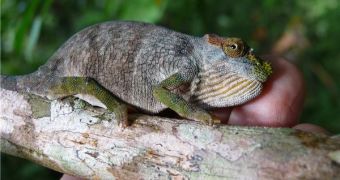A British researcher was just minding his own businesses in the jungle, surveying monkeys, when he accidentally disturbed a snake that was eating its meal. Upon inspecting the catch, the expert discovered a chameleon unlike any other species he knew. He therefore went ahead and compared the specimen to two others his colleagues had found in the same area, and published the results of these comparisons in the latest issue of the respected African Journal of Herpetology. He argues that the animal is an entirely new species of chameleon, now known as Kinyongia magomberae (the Magombera chameleon), AlphaGalileo reports.
In charge of the new investigation was University of York expert Dr Andrew Marshall, an expert in the institution's Environment Department. Marshall is only a coauthor of the new journal entry, which was written together with colleagues from the Museo Tridentino di Scienze Naturali, in Italy, the South African National Biodiversity Institute, the Anglia Ruskin University, and the University of Stellenbosch. The findings were made in the Magombera Forest, in Tanzania.
“Discovering a new species is a rare event so to be involved in the identification and naming of this animal is very exciting. Chameleon species tend to be focused in small areas and, unfortunately, the habitat this one depends on, the Magombera Forest, is under threat. Hopefully this discovery will support efforts to provide this area and others like it with greater protection,” says Marshall, who is also the director of Conservation Science at the Flamingo Land theme park and zoo.
The scientist is also the leader of a research project underway in the region, which seeks to understand the changes the forest in going through, as well as the influence that these changes have on the ecosystem. There are a lot of people depending on the fruits of the forest, but the region recently came under threat and the expert is doing everything within his power to avert the danger. In addition to supporting a large population, the forest is also home to several endangered species, such as the red colobus monkeys, which are also threatened by the changes.

 14 DAY TRIAL //
14 DAY TRIAL //